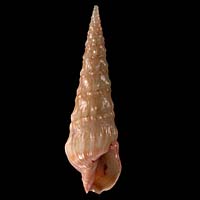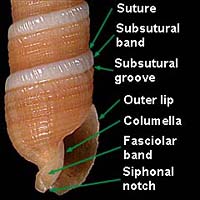|
< Previous family introduction |
|
|||||
 |
Family Terebridae Auger shells or terebras
|
|||||
|
Auger shells are one of the most spectacular groups of shelled molluscs, with their very elongate and often attractively coloured and sculptured shells. There are about 265 species in the family, with the greatest concentration of species in the tropical Indo-Pacific region, but representatives occur in the tropical eastern Pacific and Atlantic, as well as in temperate seas of Australia, New Zealand, and North and South America. Terebrids are sand dwelling animals, some living in clean sand on coral reefs, others in the surf zone of beaches, and a few in muddy sand of quieter water. In the tropics the majority occur intertidally and in the shallow subtidal, down to about 40 metres. Subtidal species, down to about 350 metres, also occur in the tropics, but are a more significant component of the fauna in temperate latitudes. All Terebridae are carnivorous, burrowing in the sand to a depth usually not exceeding the shell length, where they feed on worms. There are three different types of feeding mechanism in the family. In the first, there is a radula but no poison apparatus. In the second group, there is a venom apparatus which injects venom by harpoon-like radular teeth, as in the cones; prey is immobilised and then consumed. In the third group, there is no radula and no venom apparatus; diet in this case is slow moving worms, which are swallowed whole. There are 17 species of Terebridae in NSW. Specimens are uncommon to rare, most being obtained by trawling or dredging, or occasionally as beach washup. Of the 17 species, one, Terebra russetae, is known from only one specimen. The remainder fall into three distributional groups. A group of six species which are widespread in the tropical Indo-West Pacific intrude into the north of the state. Of this group, only two - T. nitida and T. punctatostriata - are common tropical intertidal species, the other four occurring subtidally. The second group is three species - T. ballina, T. venilia, D. bernardi - which are restricted to tropical northern and eastern Australia, reaching as far south as Sydney. The third group is six species with a southern Australian distribution, all occurring subtidally, with a lower depth limit between 25 and 550 m. The range of these is generally northern NSW southwards to Bass Strait or south-eastern SA, although this southern limit will probably be extended to south-western WA with further collecting. One of this group, T. tristis, also occurs in New Zealand. The taxonomy of the Terebridae, at the species level, was placed on a sound footing by Bratcher and Cernohorsky's monograph Living Terebras of the World, published in 1987. However, there are still taxonomic problems with five or six of the NSW species, which will only be solved with examination of further specimens of shells and animals. They point out that the generic classification of the family is unsatisfactory, being mainly based on shell characters, and this remains the situation at the time of writing (2004). I have followed Bratcher & Cernohorsky in generic assignment of species, although this is clearly unsatisfactory, particularly for the southern Australian species D. ustulata and T. assecla. The most significant work on the NSW terebrids was by Garrard (1976), in his revision of the southern Australian species of the genus Pervicacia. Family References: Bratcher, T. & Cernohorsky, W.O. 1987. Living Terebras of the World. A Monograph of Recent Terebridae of the World. American Malacologists: Melbourne, Florida Garrard, T.A. 1976. The genus Pervicacia (Terebridae: Gastropoda: Mollusca) in south-eastern Australia. Journal of the Malacological Society of Australia 3(3-4):179-185 Coverage: All species of the family known from NSW are treated here Identification Notes: The features of shells of the Terebridae are:
Shells of the Pyramidellidae differ by having no fasciolar band and often have lirae or denticles inside the outer lip. Shells of the Turritellidae have no fasciolar band. Shells of the Cerithiidae have no fasciolar band and often have varices. The shell terminology used is shown in the figure. The subsutural groove is a spiral groove that demarcates the subsutural band, a quarter or a third of the whorl height below the suture. The subsutural groove may be sharp and deep, broad and shallow, or present only as a series of punctations between axial ribs. The subsutural band is the band between suture and subsutural groove. The siphonal notch is a notch at the anterior end of the shell, that may be deep or shallow. The fasciolar band is a calloused band formed by successive edges of the siphonal notch. |
